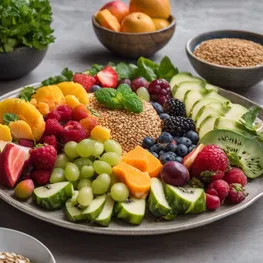Table of contents
- Understanding Blood Sugar and its Impact
- Unlocking the Secrets of Blood Sugar Management Through Diet
- Top Nutrients for Balancing Blood Sugar Levels
- Transforming Your Lifestyle to Control Blood Sugar Levels
- Tasty and Nutritious Recipes for Managing Blood Sugar Levels
Maintaining stable blood sugar levels is essential for long-term health, especially for those with diabetes or pre-diabetes. Making strategic nutritional choices can significantly impact blood sugar control and overall well-being. In this article, we will explore the best dietary approaches, food swaps, and lifestyle tips to help you achieve long-term blood sugar success and live a healthier, happier life.
Understanding Blood Sugar and its Impact
Blood sugar, also known as blood glucose, refers to the amount of glucose present in the bloodstream. It is the body's main source of energy and plays a crucial role in maintaining overall health and well-being.
Unlocking the Secrets of Blood Sugar Management Through Diet
Unlocking the Secrets of Blood Sugar Management Through Diet
-
What is Glycemic Index?
The glycemic index (GI) is a measure of how quickly and how much a specific food raises blood sugar levels.
-
Understanding Blood Sugar
Blood sugar, or glucose, is the primary source of energy for our body. Proper blood sugar management is crucial for overall health.
-
Relevance of Glycemic Index
The glycemic index is relevant to blood sugar management because it categorizes carbohydrates based on their effect on blood sugar levels.
-
Low GI vs. High GI
Foods with a low glycemic index are digested and absorbed more slowly, resulting in a slower and more steady rise in blood sugar. On the other hand, foods with a high glycemic index cause a rapid and dramatic spike in blood sugar levels.
-
Impact on Blood Sugar Control
Consuming low GI foods helps to keep blood sugar levels stable, reducing the risk of insulin resistance and diabetes. High GI foods can lead to rapid blood sugar fluctuations and contribute to weight gain and chronic diseases.
-
Other Factors to Consider
While glycemic index is an important factor, it is not the only consideration for blood sugar management. Portion sizes, overall diet quality, and individual dietary needs also play a significant role.
Top Nutrients for Balancing Blood Sugar Levels
Understanding the impact of carbohydrates on blood sugar levels is crucial when it comes to managing and balancing blood sugar levels. Carbohydrates are a major source of energy for the body, but they can also cause spikes and drops in blood sugar levels. It is important to choose the right types and amounts of carbohydrates to maintain stable blood sugar levels. Here are some key points to consider:
-
Glycemic Index
Carbohydrates have different effects on blood sugar levels based on their glycemic index (GI). High GI carbohydrates like white bread and sugary drinks cause a rapid rise in blood sugar, while low GI carbohydrates like whole grains and vegetables are digested more slowly, leading to a gradual increase in blood sugar levels.
-
Fiber
Fiber is a type of carbohydrate that is not digested by the body. It helps regulate blood sugar levels by slowing down the absorption of glucose. Consuming high-fiber carbohydrates like legumes, fruits, and vegetables can promote stable blood sugar levels.
-
Portion Control
Controlling the portions of carbohydrates consumed is important for managing blood sugar levels. Eating large amounts of carbohydrates in one sitting can cause a spike in blood sugar. It is recommended to spread carbohydrate intake throughout the day and opt for smaller portions.
-
Quality of Carbohydrates
Choosing carbohydrates that are minimally processed and nutrient-dense is essential for balancing blood sugar levels. Whole grains, fruits, and vegetables provide important vitamins, minerals, and fiber, whereas refined carbohydrates like white bread and sugary snacks lack these nutrients and can lead to blood sugar imbalances.
-
Timing of Carbohydrate Consumption
When you eat carbohydrates can also impact blood sugar levels. It is beneficial to consume carbohydrates alongside protein and healthy fats, as these macronutrients help slow down the digestion and absorption of carbohydrates, preventing sudden spikes in blood sugar.
Regular exercise plays a crucial role in maintaining healthy blood sugar levels, especially for those looking to control their blood sugar levels and transform their lifestyle. By incorporating regular exercise into your routine, you can experience several benefits:
- Improved insulin sensitivity: Exercise helps your muscles use insulin more effectively, allowing them to take in glucose and use it for energy. This results in better blood sugar control.
- Weight management: Exercise can aid in weight loss, which is essential for controlling blood sugar levels. Regular physical activity burns calories, increases metabolism, and helps maintain a healthy weight.
- Reduced insulin resistance: Exercise reduces insulin resistance, a condition where the body's cells do not respond effectively to insulin. By improving insulin sensitivity, exercise helps lower blood sugar levels.
- Lowered risk of type 2 diabetes: Regular exercise can prevent or delay the onset of type 2 diabetes by improving insulin sensitivity and maintaining a healthy weight. It also helps reduce the risk of complications associated with diabetes.
- Improved cardiovascular health: Exercise provides numerous cardiovascular benefits, such as lower blood pressure, improved circulation, and reduced risk of heart disease. These benefits contribute to better overall blood sugar control.
- Stress reduction: Physical activity releases endorphins, which are known for reducing stress levels. Lower stress levels can help regulate blood sugar levels and prevent emotional eating.
- Improved overall health: Regular exercise has a positive impact on overall health, including better sleep, increased energy levels, improved mood, and a stronger immune system.
Tasty and Nutritious Recipes for Managing Blood Sugar Levels
Maintaining healthy blood sugar levels is crucial for overall health. If you're looking for delicious and nutritious recipes that are low in sugar and high in nutrients, we've got you covered. Here are some recipe ideas for breakfast, lunch, dinner, and snacks that can help you manage your blood sugar levels effectively:
- Breakfast: Start your day with a power-packed omelet made with egg whites, spinach, and mushrooms. Add a side of fresh berries for a touch of natural sweetness.
- Lunch: Enjoy a colorful and satisfying salad filled with leafy greens, grilled chicken, avocado, and cherry tomatoes. Top it off with a light vinaigrette made with olive oil and lemon juice.
- Dinner: Opt for a lean protein like salmon or baked chicken breast and pair it with a generous serving of roasted vegetables such as broccoli, cauliflower, and Brussels sprouts. Season with herbs and spices for added flavor.
- Snacks: Reach for a handful of nuts like almonds or walnuts, which provide healthy fats and protein to keep you feeling full. Alternatively, enjoy a Greek yogurt with a sprinkle of cinnamon or a small apple with a serving of peanut butter.
- Remember to focus on whole, unprocessed foods that are rich in fiber, protein, and healthy fats. These recipes will not only keep your blood sugar in check but also provide the necessary nutrients for a balanced diet.
In conclusion, making strategic nutritional choices is essential for maintaining long-term blood sugar success. By following a balanced diet that includes complex carbohydrates, lean proteins, healthy fats, and plenty of fruits and vegetables, individuals can regulate their blood sugar levels effectively. Additionally, portion control and mindful eating play crucial roles in managing blood sugar. Regular exercise and staying hydrated further support overall blood sugar control. By adopting these lifestyle changes and consulting with healthcare professionals, individuals can significantly improve their long-term blood sugar management and maintain optimal health.
Frequently asked questions related to strategic nutritional choices
What are strategic nutritional choices?
Strategic nutritional choices are specific food choices that help to stabilize blood sugar levels and promote long-term blood sugar success. These choices involve selecting foods that have a low glycemic index, are high in fiber, and contain balanced amounts of protein, carbohydrates, and fats.
What is the glycemic index?
The glycemic index (GI) is a measure of how quickly carbohydrates in a food raise blood sugar levels. Foods with a high GI cause a rapid spike in blood sugar, while foods with a low GI cause a slower and more gradual increase. Choosing foods with a low GI can help to prevent sudden blood sugar spikes and crashes.
What types of foods have a low glycemic index?
Foods that have a low glycemic index include non-starchy vegetables, whole grains, legumes, nuts, and seeds. These foods are digested and absorbed more slowly, resulting in a slower release of glucose into the bloodstream. Examples of low GI foods include broccoli, quinoa, lentils, almonds, and chia seeds.
Why is stabilizing blood sugar important for long-term success?
Stabilizing blood sugar is important for long-term success because fluctuating blood sugar levels can lead to various health problems, including type 2 diabetes, obesity, cardiovascular disease, and metabolic syndrome. By keeping blood sugar levels stable, individuals can maintain energy levels, control cravings, and reduce the risk of developing these chronic conditions.
What is the recommended balance of macronutrients for blood sugar success?
The recommended balance of macronutrients for blood sugar success is approximately 50% carbohydrates, 30% fat, and 20% protein. This balance helps to provide a steady release of glucose into the bloodstream, maintain energy levels, and support overall health. It is important to choose high-quality carbohydrates, healthy fats, and lean sources of protein.
Why is fiber important for blood sugar management?
Fiber plays a crucial role in blood sugar management because it slows down the absorption of sugar from food, which helps to prevent blood sugar spikes. It also promotes a feeling of fullness, aids in digestion, and supports a healthy gut microbiome. Foods that are high in fiber include fruits, vegetables, whole grains, legumes, and nuts.







